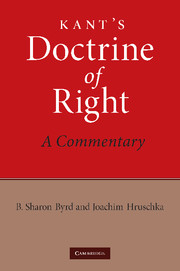Book contents
- Frontmatter
- Contents
- Introduction and methods of interpretation
- Chapter 1 The idea of the juridical state and the postulate of public law
- Chapter 2 The state of nature and the three leges
- Appendix to Chapter 2 Iustitia tutatrix, iustitia commutativa, and iustitia distributiva and their differences
- Chapter 3 The right to freedom
- Chapter 4 The permissive law in the Doctrine of Right
- Chapter 5 The external mine and thine
- Chapter 6 Intelligible possession of land
- Chapter 7 The “state in the idea”
- Chapter 8 The state in reality
- Chapter 9 International and cosmopolitan law
- Chapter 10 The “idea of public law” and its limits
- Chapter 11 Contract law I. Why must I keep my promise?
- Chapter 12 Contract law II. Kant's table of contracts
- Chapter 13 Criminal punishment
- Chapter 14 The human being as a person
- Appendix I to Chapter 14 On the logic of “‘ought’ implies ‘can’”
- Appendix II to Chapter 14 The system of rules of imputation
- Bibliography
- Index
Appendix II to Chapter 14 - The system of rules of imputation
Published online by Cambridge University Press: 05 June 2012
- Frontmatter
- Contents
- Introduction and methods of interpretation
- Chapter 1 The idea of the juridical state and the postulate of public law
- Chapter 2 The state of nature and the three leges
- Appendix to Chapter 2 Iustitia tutatrix, iustitia commutativa, and iustitia distributiva and their differences
- Chapter 3 The right to freedom
- Chapter 4 The permissive law in the Doctrine of Right
- Chapter 5 The external mine and thine
- Chapter 6 Intelligible possession of land
- Chapter 7 The “state in the idea”
- Chapter 8 The state in reality
- Chapter 9 International and cosmopolitan law
- Chapter 10 The “idea of public law” and its limits
- Chapter 11 Contract law I. Why must I keep my promise?
- Chapter 12 Contract law II. Kant's table of contracts
- Chapter 13 Criminal punishment
- Chapter 14 The human being as a person
- Appendix I to Chapter 14 On the logic of “‘ought’ implies ‘can’”
- Appendix II to Chapter 14 The system of rules of imputation
- Bibliography
- Index
Summary
According to Kant's definition, imputation is the judgment through which someone is seen as the author, namely the free cause, of an action “which is then called deed (factum) and is subject to the laws.” This definition is not simply a repetition of Wolff's claim that the application of a law to an act implies imputation of this act. Instead Kant surpasses Wolff by saying that imputation of an action as a “deed (factum)” subjects the action to the law. Imputing an action to another person means I not only see the action as freely undertaken, but also evaluate the action under moral laws. Wolff sees applying the law as a sufficient condition for imputing an action and Kant agrees. Still, Kant also sees imputing the action as a sufficient condition for applying the law. Freedom cannot be conceived other than as freedom subject to the rules of practical reason (morality), or laws of freedom.
The relevant laws to which actions are subjected are not only prescriptions and proscriptions (“You should render first aid!,” “You should not steal!”), but also permissive laws, and primarily the permissive law in §2 of the Doctrine of Right with its extensive consequences for property, contract, and family law. Let us consider legal possession of things, meaning ownership of those things. This legal possession is different from merely physical possession, which belongs to the sensible world and to theoretical cognition of this sensible world.
- Type
- Chapter
- Information
- Kant's Doctrine of RightA Commentary, pp. 298 - 308Publisher: Cambridge University PressPrint publication year: 2010



